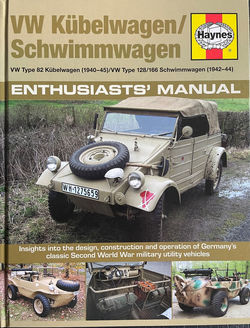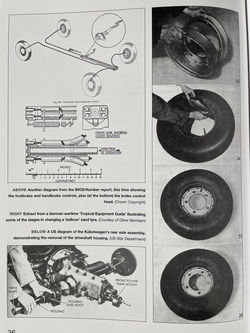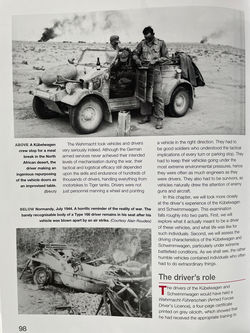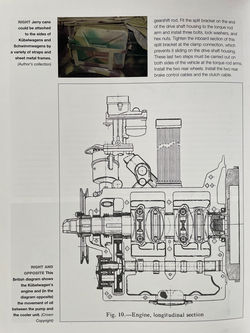HAYNES VOLKSWAGEN
KUBELWAGEN Type 82 SCHWIMMWAGEN Type 128/166 WW2 GERMAN ARMY 1940-1945
HARDBOUND BOOK BY CHRIS McNAB IN ENGLISH
DEVELOPMENT TESTING PRODUCTION
---------------------------------------------------------------------------
Additional
Information from Internet Encyclopedia
The VW Type 128 and 166 Schwimmwagen
(literally Floating/Swimming Car)
were amphibious four-wheel drive off-roaders, used extensively by German ground
forces during the Second World War. The Type
166 is the most numerous mass-produced amphibious car in history.
Volkswagen
Schwimmwagens used the engine and mechanicals of the VW Type 86 four-wheel
drive prototype of the K�belwagen and the Type 87 four-wheel drive
'K�bel/Beetle' Command Car, which in turn were based on the platform of the
civilian Volkswagen Beetle. Erwin Komenda, Ferdinand Porsche's first car body
designer, was forced to develop an all-new unitized bodytub structure since the
flat floorpan chassis of the existing VW vehicles was unsuited to smooth
movement through water. Komenda patented his ideas for the swimming car at the
German Patent office.
The earliest Type
128 prototype was based on the full-length K�belwagen chassis with a
240 cm (7.9 ft) wheelbase. Pre-production units of the 128, fitted
with custom welded bodytubs, demonstrated that this construction was too weak
for tough off-roading, had insufficient torsional rigidity, and easily suffered
hull-ruptures at the front cross-member, as well as in the wheel-wells. This
was unacceptable for an amphibious vehicle. The large-scale production models
(Type 166) were therefore made smaller, and had a wheel-base of only
200 cm (6.6 ft).
VW Schwimmwagens
were produced by the Volkswagen factory at Fallersleben / Wolfsburg and
Porsche's facilities in Stuttgart; with the bodies (or rather hulls) produced
by Ambi Budd in Berlin. 15,584 Type 166 Schwimmwagen cars were produced from
1941 through 1944; 14,276 at Fallersleben and 1,308 by Porsche. Given these
numbers, the VW 166 is the most mass-produced amphibious car in history. Only
163 are known by the Schwimmwagen Registry to remain today, and only 13 have
survived without restoration work.
All Schwimmwagen
were four wheel drive only on first gear (and reverse gears with some models)
and had ZF self-locking differentials on both front and rear axles. Just like
the K�belwagen, the Schwimmwagen had portal gear rear hubs that gave better
ground clearance, while at the same time reducing drive-line torque stresses
with their gear reduction at the wheels.
When crossing
water a screw propeller could be lowered down from the rear deck engine cover.
When in place a simple coupling provided drive straight from an extension of
the engine's crankshaft. This meant that screw propulsion was only available
going forward. For reversing in the water there was the choice of using the
standard equipment paddle or running the land drive in reverse, allowing the
wheel-rotation to slowly take the vehicle back. The front wheels doubled up as
rudders, so steering was done with the steering wheel both on land and on
water.
The Volkswagen K�belwagen
(literally, "bucket car", previously mostly used for rail, industrial
or agricultural hopper cars) was a light military vehicle designed by Ferdinand
Porsche and built by Volkswagen during World War II for use by the German
military (both Wehrmacht and Waffen-SS). Based heavily on the
Volkswagen Beetle, it was prototyped as the Type 62, but eventually became known internally as the Type 82.
K�belwagen is an
abbreviation of K�belsitzwagen,
meaning "bucket-seat car" because all German light military vehicles
that had no doors were fitted with bucket seats to prevent passengers from
falling out. The first VW test vehicles had no doors and were therefore fitted
with bucket seats, so acquiring the name VW K�belsitzwagen that was later shortened to K�belwagen. Mercedes, Opel and Tatra
also built K�bel(sitz)wagens.
With its rolling
chassis and mechanics built at Stadt des KdF-Wagens (renamed Wolfsburg after
1945), and its body built by US-owned firm Ambi Budd Presswerke in Berlin, the K�belwagen was for the Germans what
the Jeep and GAZ-67 were for the Allies.
Although Adolf
Hitler discussed with Ferdinand Porsche the possibility of military application
of the Volkswagen as early as April 1934, it was not until January 1938, that
high-ranking Third Reich army officials formally approached Porsche about
designing an inexpensive, light-weight military transport vehicle, that could
be operated reliably both on- and off-road, in even the most extreme
conditions. This implied that the Beetle could provide the basis for such a
vehicle.
Porsche began work
on the project immediately, having a prototype of the vehicle ready within the
month, but realized during development that it would not be enough to reinforce
the Beetle's chassis to handle the stresses that military use would place on
it. In order to guarantee adequate off-road performance of a two-wheel-drive
vehicle with a 1,000 cc FMCV 1 engine, it would have to be lightweight. In
fact, the army had stipulated a laden weight of 950 kg (2,090 lb),
including four battle-dressed troops, which meant that the vehicle itself
should not weigh more than 550 kg (1,210 lb). Porsche therefore
sub-contracted Trutz, an experienced military coachbuilder, to help out with
the body design.
Developmental
testing by the military began after a presentation of the prototypes designated
as Type 62 in November 1938. Despite lacking four wheel drive, a mainstay of
the American military Jeeps, the vehicle proved very competent at maneuvering
its way over rough terrain, even in a direct comparison with a contemporary
standard German army 4�4, and the project was given the green light for further
development. The vehicle's light weight and ZF self-locking differential
compensated for the lack of 4�4 capabilities.
Further
development of the Type 62 took place during 1939, including a more angular
body design, and pre-production models were field-tested in the invasion of
Poland, that started in September that year. Despite their overall satisfaction
with the vehicle's performance, military commanders demanded that a few
important changes be made: the lowest speed of the vehicle had to be reduced
from 8 km/h (5.0 mph) to 4 km/h (2.5 mph) as an adjustment
to the pace of marching soldiers. Second, it needed some improvement of its
off-road ability. Porsche responded to both requests by mounting new axles with
gear-reduction hubs, providing the car with more torque and more ground-clearance
all at once. Revised dampers, 41 cm (16 in) wheels, and a limited
slip differential, as well as countless small modifications, completed the
specification. In order to reflect the changes, the vehicle was renamed Type
82.
Full-scale production
of the Type 82 K�belwagen
started in February 1940, as soon as the VW factories had become operational.
No major changes took place before production ended in 1945, only small
modifications were implemented, mostly eliminating unnecessary parts and reinforcing
some, which had proved unequal to the task. Prototype versions were assembled
with four-wheel-drive (Type 86) and different engines, but none offered a
significant increase in performance or capability over the existing Type 82 and
the designs were never implemented. As of March 1943, the car received a
revised dash and the bigger 1,131 cc engine, developed for the Schwimmwagen, that produced more
torque and power than the original 985 cc unit. When Volkswagen production
ceased at the end of the war, 50,435 K�belwagen
vehicles had been produced, and the vehicle had proven itself to be
surprisingly useful, reliable, and durable.
Long after the end
of the war, VW resurrected the basic K�belwagen
design as the 1969 Type 181, developed for the German Federal Armed Forces and
later also produced for the civilian market, known as "Thing" in the
US, "Trekker" in the UK, and "Safari" in Mexico. Although
similar in looks and design, almost no parts were interchangeable with the Type
82.
When the German military took delivery of the first vehicles, they
immediately put them to the test on- and off-road in snow and ice to test their
capability at handling European winters. Several four-wheel-drive vehicles were
used as reference points. The two-wheel-drive K�belwagen surprised even those who had been a part of its
development, as it handily out-performed the other vehicles in nearly every
test. Most notably, thanks to its smooth, flat underbody, the K�bel would propel itself much like a
motorised sled, when its wheels were sinking into sand, snow, or mud, allowing
it to follow tracked vehicles with remarkable tenacity.
In November 1943, the U.S. military conducted a series of tests as well on
several Type 82s they had captured in North Africa. In U.S. War Department
Technical Manual TM-E 30-451, Handbook
on German Military Forces, dated 15 March 1945 (p. 416), it states
"The Volkswagen, the German equivalent of the American 'Jeep', is inferior
in every way, except in the comfort of its seating accommodations."
At the same time,
another K�belwagen, also
captured in North Africa, had been dissected in Britain by engineers of the
Humber Car Company, whose report was equally unfavourable and dismissive.
Among the design
features that contributed to the K�belwagen's performance were:
- Light weight, although some
41 cm (16 in) longer than the Willys MB, it was over 300 kg
(660 lb) lighter.
- Very flat and smooth underbody,
that allowed the car to slide over the surface it was traversing.
- Considerable ground clearance,
roughly 28 cm (11 in), in part thanks to:
- The use of portal gear hub
reduction, providing more torque and ride height simultaneously.
- Independent suspension on all
four wheels.
- Self-locking differential,
limiting slippage and retaining traction.
Apart from that,
the air-cooled engine proved highly tolerant of hot and cold climates, and less
vulnerable to bullets, due to the absence of a radiator. For starting under
winter conditions, a specially volatile starting fuel was required, contained
in a small auxiliary fuel tank.
As the body was
not a load-bearing part of the structure of the vehicle, it could easily be
modified to special purposes.
The K�belwagen could reach a top speed of
80 km/h (50 mph).
The following body types and
variants of the Type 82 were produced:
Type
62: Prototype K�belwagen,
constructed from 15 May 1938; pre-production models (1939) field tested in the
invasion of Poland
Type
67: 2-stretcher ambulance; Type 60 Beetle chassis with modified Type 82 body
Type
82/0: Basic four seater
Type
82/I: Three-seat radio car
Type
82/2: Sirencar (Siemens motordriven siren mounted on passenger side in place of
the rear seat)
Type
82/3: Mock-up armoured vehicle/command car with machine gun-fitted turret over
the cabin
Type
82/5: K�belwagen chassis with
the Type 60 LO Lieferwagen
(open pickup truck) body[6]
Type
82/6: Tropical version sedan-body box van
Type
82/7: Three-seat 'Command car' made up of a Type 82 chassis, fitted with a
Beetle body and roll-up canvas roof section. These three-seaters had a
co-drivers seat with fully reclining backrest for the commander.
Type
82/8: Like Type 82/0 but had an open body made of wood
Type
82/E: K�belwagen chassis with
Beetle body (688 manufactured)
Type
86: All-wheel drive prototype (6 fabricated)
Type
87: "Kommandeurwagen"
Type 86 4�4 K�belwagen chassis
with Beetle command car body. Fitted with running boards, under-hood-mounted
spare tire (accompanied by a gas can, a jack, a small tool kit, and a shovel),
and widened fenders for its larger-diameter Kronprinz (Crown Prince) off-road tires, some were provided to
preferred officers, who could push through virtually any kind of terrain with
them (667 produced)
Type
89: Fitted with an experimental automatic transmission
Type
98: Beetle cabriolet body with the K�belwagen
4�4 drive train
Type
106: Fitted with an experimental transmission (assumed different from the Type
89)
Type
107: Fitted with a turbocharger
Type
115: Fitted with a supercharger
Type
126: Fitted with a fully synchronized gearbox (assumed different from the Type
278)
Type
155/1: Half-track / snow-track K�belwagen
prototype. Pictures of several track-set designs exist,
although it is possible, that these were consecutively fitted to the same
prototype. Trials proved, that the Type 155 was able to cover the most
difficult terrain, but the modifications necessary to the standard K�belwagen were extensive and the
resulting vehicle was both very slow and forbiddingly inefficient.
Type
157: Railway car equipment, used for Types 82 and 87
Type
164: Six-wheeled, twin engine, dual-control prototype; never entered production
Type
177: Fitted with a five-speed transmission (as opposed to the standard
four-speed unit)
Type
179: Fitted with fuel-injected Volkswagen engine
Type
179-F: Later updated directly to the Schwimmwagen
(mentioned above)�Could cross water and temporarily be used as a small boat
and/or landing craft. Because of a thick and bulletproof skid plate, the engine
was protected and all valves in the rear were airtight. The engine had a
flush-activated 179 Fuel Injected engine, that would act as a drainer to push
water out and prevent the engine from flooding.
Type
198: Fitted with a PTO and auxiliary gearbox for starting the engines of
armoured fighting vehicles
Type
235: Fitted for power by an electric motor
Type
239: Fitted for power by a wood-gas generator mounted on the nose (also listed
as Type 230)
Type
240: Fitted for power by bottled gas
Type
276: Type 82 fitted with a towing hook to pull a 37 PAK gun
Type
278: Fitted with synchronized gearbox
Type
307: Fitted with a heavy-duty carburetor
Type
309: Prototype fitted with a diesel engine
Type
331: Prototype fitted for power by a "native fuel system" (acetylene
gas) engine (also listed as Type 231)
Type
332: Fitted for power by anthracite coal









